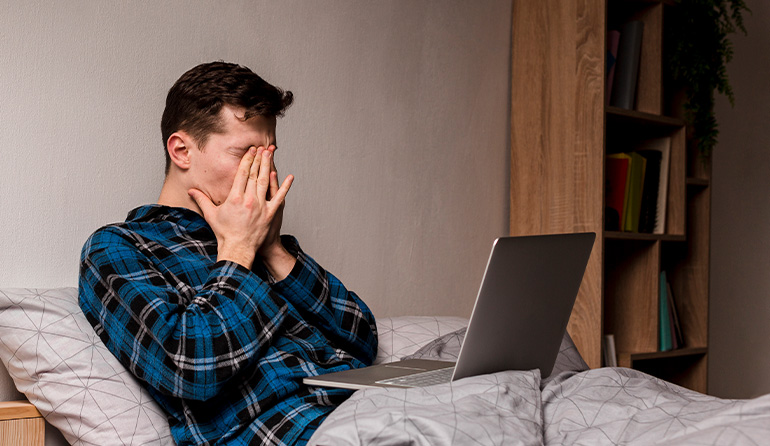
Link Between Glaucoma and Poor Sleep
A good night’s sleep is not a luxury; it is essential for a healthy life. Recent studies have shed light on the relationship between sleep quality and chronic eye diseases. Significant connections have been found especially between glaucoma and various sleep disorders.
Glaucoma is often called the “silent thief” because it shows no symptoms until it progresses. However, new data reveal that glaucoma affects not only vision loss but also individuals’ overall quality of life, daily functioning, and even mental health. As visual field loss advances, patients experience difficulties with basic tasks like driving at night, climbing stairs, reading, or recognizing faces. This loss of function can lead to increased stress, anxiety, and social isolation. When sleep disorders accompany glaucoma, this cycle worsens. Survey-based studies on glaucoma patients show that those with poor sleep quality have higher rates of depressive symptoms and difficulty in daily activities. Disruptions in melatonin release during sleep may affect not only the biological clock but also mood. Glaucoma is more than an eye disease; it has systemic effects and requires a multidisciplinary approach. Therefore, patients diagnosed with glaucoma should be assessed not only for intraocular pressure but also for lifestyle habits, sleep quality, risk of sleep apnea, and mental health in a holistic manner.
Glaucoma and Sleep Patterns: A Neurological Connection
While our body rests during sleep, the brain remains active; new neural connections are formed, memory is reinforced, and the nervous system is balanced. Poor sleep quality disrupts this balance and may trigger the progression of neurodegenerative diseases, including glaucoma. A large-scale study based on data from the U.S. National Health and Nutrition Examination Survey (NHANES) found significant links between sleep duration and quality, optic nerve damage, and visual field loss in glaucoma patients. Participants were evaluated through fundus photography and automated visual field tests, revealing the following findings:
- Individuals sleeping more than 10 hours per night are three times more likely to have glaucoma compared to those sleeping 7 hours.
- Those who fall asleep in less than 9 minutes or more than 30 minutes have double the risk of glaucoma.
- People sleeping less than 3 hours or more than 10 hours face three times the risk of vision loss compared to those with the ideal 7-hour sleep.
- People reporting daytime sleepiness with difficulty remembering things are twice as likely to experience visual field loss than those without sleepiness or memory problems.
- Those who feel sleepy during the day and struggle with hobbies are more likely to have vision loss compared to those without daytime sleepiness and no difficulty in hobbies.
These findings show that sleep duration and quality are critical not only for general health but also for eye health.
Obstructive Sleep Apnea and Glaucoma
Obstructive Sleep Apnea Syndrome (OSAS) is a serious disorder characterized by repeated airway blockage during sleep. OSAS is associated with systemic problems like high blood pressure, heart disease, stroke, and also glaucoma. Studies suggest that individuals with sleep apnea may have a tenfold increased risk of developing glaucoma. Recently developed contact lens sensors (CLS) enable continuous 24-hour monitoring of intraocular pressure (IOP), especially at night. These technologies contribute to a better understanding of the link between glaucoma and sleep apnea.
Sleep Positions and Intraocular Pressure
Studies show that intraocular pressure is higher in the lying down position compared to sitting. This difference is more pronounced in glaucoma patients. Certain sleep positions, especially lying face down or on the side, may increase IOP in one eye, causing asymmetric optic nerve damage. The exact mechanism is not fully understood, but factors such as increased episcleral venous pressure and changes in choroidal blood flow may play a role.
Prevention and Early Diagnosis: Regular Eye Exams Are Essential
Glaucoma usually progresses silently and shows symptoms late. For this reason, regular eye exams starting at age 40 are crucial for early diagnosis. Those with risk factors-such as sleep disorders or OSAS-should be monitored more frequently.
Conclusion and Recommendations
- Sleep duration and quality are closely related to the development and progression of glaucoma.
- Managing systemic diseases like sleep apnea may reduce glaucoma risk.
- The effect of sleep positions, especially prolonged face-down sleeping, on intraocular pressure should be considered.
- Screening for glaucoma is advisable in individuals with sleep disorders.
Eye health professionals should educate patients about sleep hygiene and collaborate with sleep specialists when necessary.
July 2025




